
eBook - ePub
The Beatles vs. The Rolling Stones
Sound Opinions On the Great Rock 'N' Roll Rivalry
Jim DeRogatis, Greg Kot
This is a test
Compartir libro
- 192 páginas
- English
- ePUB (apto para móviles)
- Disponible en iOS y Android
eBook - ePub
The Beatles vs. The Rolling Stones
Sound Opinions On the Great Rock 'N' Roll Rivalry
Jim DeRogatis, Greg Kot
Detalles del libro
Vista previa del libro
Índice
Citas
Información del libro
Two of the world's preeminent music journalists tackle the liveliest debate in rock history: which band is the greatest ever—the Beatles or the Rolling Stones? More than two dozen topics of debate are addressed, with cases being made both for the lads from Liverpool and rock's proto bad boys. From the Cavern and Crawdaddy clubs through head-to-head comparisons of specific albums (e.g., Exile or "the White Album"?), members' roles within the bands, the Svengali-like managers, influential producers, musical influences, and more, this is the book that dares confront the topics over which fans have agonized for years. Illustrated throughout with photography and memorabilia.
Preguntas frecuentes
¿Cómo cancelo mi suscripción?
¿Cómo descargo los libros?
Por el momento, todos nuestros libros ePub adaptables a dispositivos móviles se pueden descargar a través de la aplicación. La mayor parte de nuestros PDF también se puede descargar y ya estamos trabajando para que el resto también sea descargable. Obtén más información aquí.
¿En qué se diferencian los planes de precios?
Ambos planes te permiten acceder por completo a la biblioteca y a todas las funciones de Perlego. Las únicas diferencias son el precio y el período de suscripción: con el plan anual ahorrarás en torno a un 30 % en comparación con 12 meses de un plan mensual.
¿Qué es Perlego?
Somos un servicio de suscripción de libros de texto en línea que te permite acceder a toda una biblioteca en línea por menos de lo que cuesta un libro al mes. Con más de un millón de libros sobre más de 1000 categorías, ¡tenemos todo lo que necesitas! Obtén más información aquí.
¿Perlego ofrece la función de texto a voz?
Busca el símbolo de lectura en voz alta en tu próximo libro para ver si puedes escucharlo. La herramienta de lectura en voz alta lee el texto en voz alta por ti, resaltando el texto a medida que se lee. Puedes pausarla, acelerarla y ralentizarla. Obtén más información aquí.
¿Es The Beatles vs. The Rolling Stones un PDF/ePUB en línea?
Sí, puedes acceder a The Beatles vs. The Rolling Stones de Jim DeRogatis, Greg Kot en formato PDF o ePUB, así como a otros libros populares de Medien & darstellende Kunst y Rockmusik. Tenemos más de un millón de libros disponibles en nuestro catálogo para que explores.
Información
Categoría
Medien & darstellende KunstCategoría
Rockmusik
JD: As we look at the perplexing question of which was the cooler band, the Beatles or the Rolling Stones, I think we need to start at the beginning, both in terms of the history as well as the images that both groups were expert in creating. The essential paradox is that the Stones would excel at positioning themselves as the baddest bad boys of rock ’n’ roll—“Would you let your sister go with a Rolling Stone?”—while the Beatles were positioned as endlessly cute, cuddly, and lovable—the acceptable face of the counterculture for blue hairs and little kids alike. Yet, the Beatles had a rough-and-tumble upbringing as lower-middle-class if not lower-class kids on the streets of Liverpool—by no means a cultural mecca—and the key players in the Stones had pretty privileged upbringings.
Mick Jagger was from a middle-class family, and he went to Wentworth Primary School in Dartford, where he met Keith Richards. Keith ended up going to Sidcup Art College, while Jagger enrolled at the London School of Economics. And Brian Jones was better off than both of them: He grew up in the provinces, fairly coddled as a grammar-school boy at Cheltenham, and a model student who aced his exams. That’s not the case for the Fab Four!

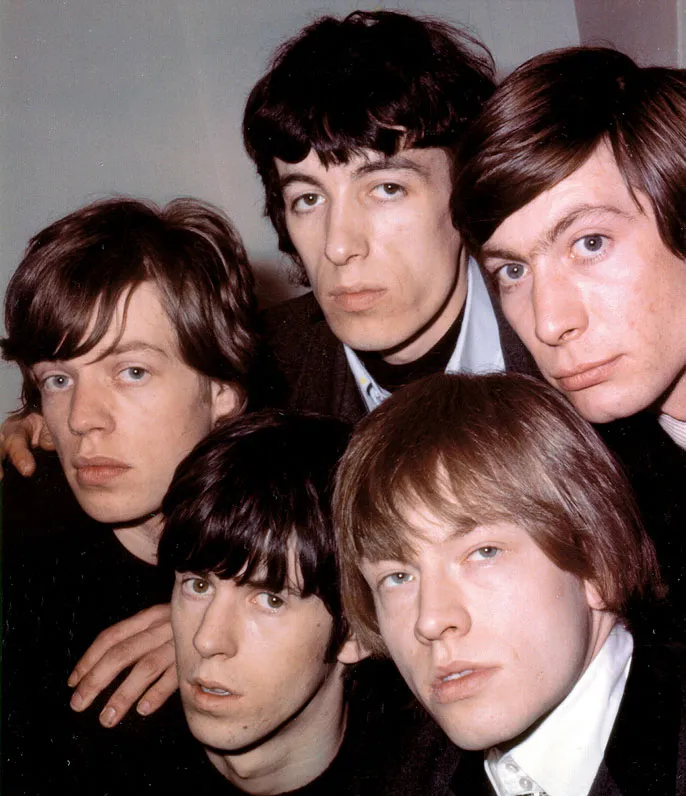

A youngster strolls past a nightclub in Hamburg’s notorious Reeperbahn.
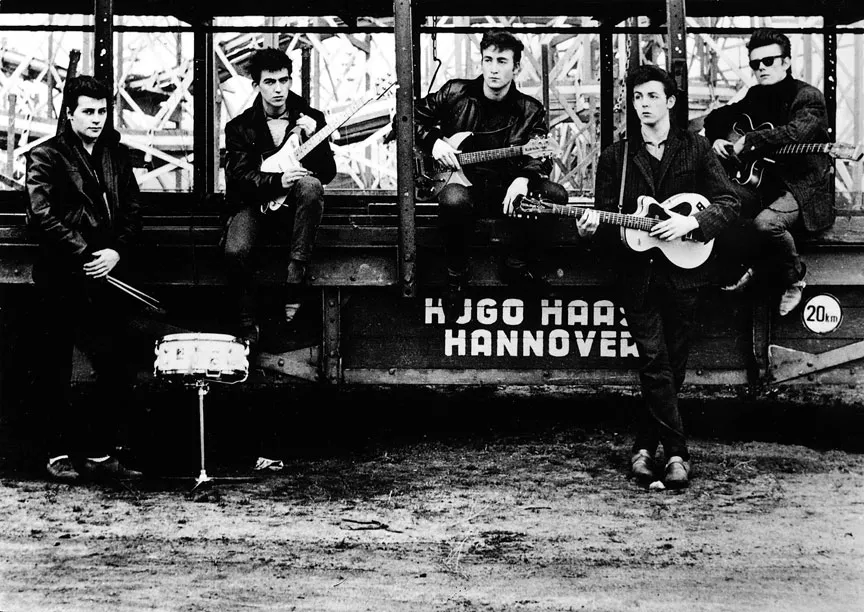
Oozing attitude: the Beatles at the Hamburg Funfair. From left: Pete Best, George Harrison, John Lennon, Paul McCartney, and Stuart Sutcliffe.
GK: Early Beatles history sometimes gets written out, but when they were learning how to be a band at those clubs in Hamburg, they were in the den of iniquity, the Babylon of rock ’n’ roll, a prostitution center of Germany.
JD: I’ve been to the Reeperbahn, Hamburg’s red-light district, and it’s a trip! I grew up across the Hudson River from New York City, and I’ve got to say that Times Square at its seediest, before it was cleaned up and turned into a Disney-esque shopping mall, had nothing on the Reeperbahn! There, you could walk down the street and see girls half-naked in the windows, cheerfully snorting drugs while waiting for their next john!
GK: You look at the pictures from the Beatles in that era, with the leather jackets, black jeans, T-shirts. . . . They had every bit of the attitude oozing from them in the early, early days that the Stones did when they surfaced. However, it was out of the public limelight. They were playing frenetic sets jacked up on speed. It was crude, lewd, punky—everything the Stones would later be portrayed as embodying. The differences in terms of image would be shaped and dramatized later by their respective managers. Understand the differences between Brian Epstein and Andrew “Loog” Oldham, and you understand how these bands were packaged, marketed, and presented to the world. The truth wasn’t necessarily obscured, but it was manipulated for public consumption. Malcolm McLaren, manager of the Sex Pistols, had nothing on these guys. In fact, he probably learned a hell of a lot by studying how Oldham turned the Stones into villains.
A critical difference was that Epstein was born in 1934 and Oldham in 1944, ten years apart. Oldham actually worked public relations in the very early days of the Beatles as they were breaking out of the Liverpool scene, so he saw firsthand the spin that Epstein was putting on the Beatles’ image. Oldham came up in the same postwar generation as the Stones. He was a contemporary, whereas Epstein came off as more of an uncle, an elder voice of reason and experience. The swinging London of 1962–1965 was Oldham’s world.

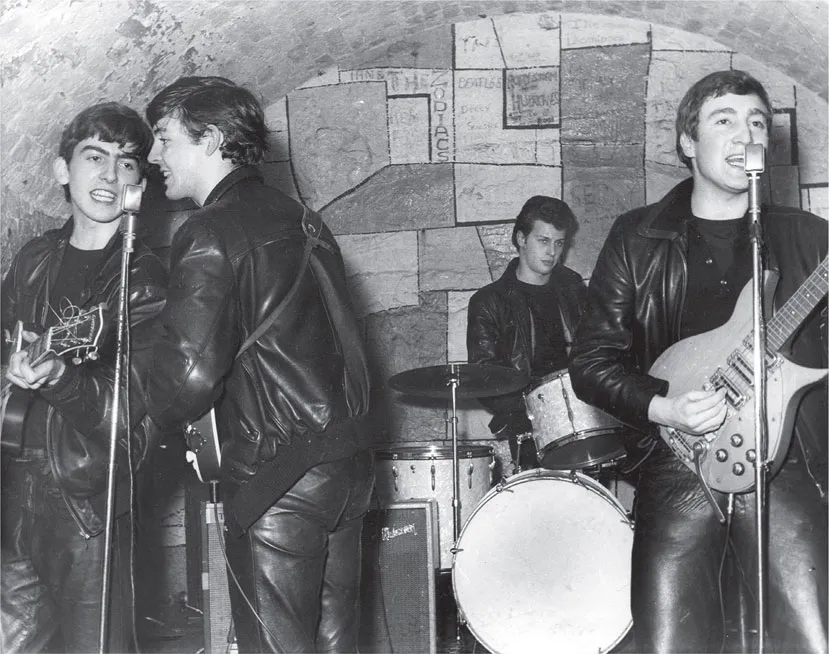
Performing at the Cavern Club, Liverpool, February 1961.
He grew up with rock ’n’ roll as his soundtrack. Epstein, on the other hand, was a music snob. He managed a record store in Liverpool, and he didn’t much like rock ’n’ roll. He preferred classical music. But he saw the Beatles play at the Cavern Club, and he loved not so much what he heard but what he saw and felt—the aura and excitement around the band, and the way that young people reacted to them. The Beatles looked and acted like “rough trade,” and Epstein saw that this was not just about music but about a certain charisma and sexuality that had appeal for both men and women. All they needed was a little coaching and polishing, and Epstein understood polishing. He got them to wear matching suits, to structure their set lists, to give the unison bow at the end of each show. The Beatles were skeptical at first, but they also saw Epstein as a successful businessman who could take them places they couldn’t go without help from a grownup.
Finally, Epstein and Oldham led the bands to a couple of crucial lineup decisions. Epstein brought the Beatles to another pro, producer George Martin, and Martin, in turn, said the Beatles needed to get rid of Pete Best as the drummer. He couldn’t keep up with the other guys. Best was out, and Ringo Starr was in—in retrospect, a key contribution to their sound. Similarly, Oldham pushed really hard to get Charlie Watts in the Stones. It’s easy to diss the managers and say they were manipulative, but some of those hard calls early on helped these bands get to where they wanted to be. By 1967, their influence on the bands had diminished considerably. Oldham left the Stones because he hated Their Satanic Majesties Request. He said, “I don’t even understand you guys anymore.”
JD: “You have lost the plot.”
GK: I’m not sure the Stones understood themselves anymore at that point, either. Then Epstein died in 1967. It truly was the end of an era for both bands when these two once-all-powerful managers outlived their usefulness. But for those four to five years early on, the Beatles and the Stones wouldn’t have been the same without Oldham and Epstein behind the scenes.

Lennon prepares to meet the Queen Mother after asking her to rattle her jewelry at the Royal Variety Performance, Prince of Wales Theatre, London, November 4, 1963.
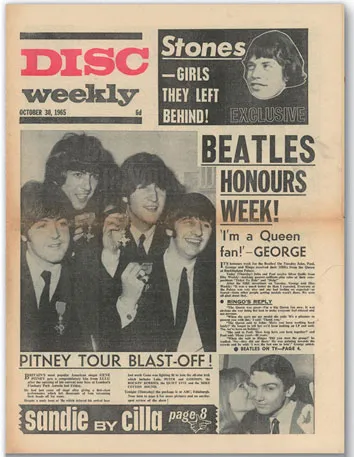
Disc Weekly reports on the lovable mop tops accepting their MBEs, October 30, 1965.
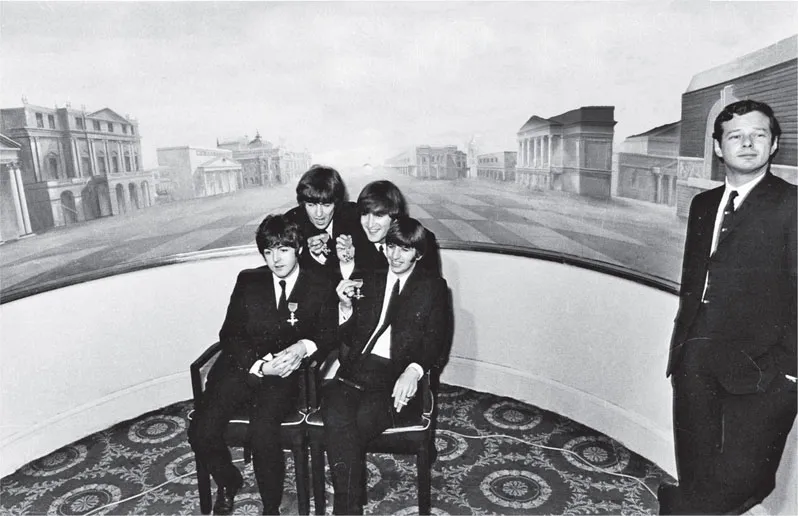
An elder voice of reason and experience. Beatles manager Brian Epstein with the Beatles at Buckingham Palace after they received their MBEs, October 26, 1965.
JD: It’s always hard for us as Americans who were not even contemporaries of these movements to judge how they were viewed at the moment—to put ourselves back in postwar London and understand what Great Britain was like at the time. Plus, as Americans, we don’t understand the British class system or how that was affected by the U.K. coming within a hair of falling to the Nazis not all that long before these musicians were born. America, in comparison, was the Wild West. It embraced James Dean and the early rock ’n’ rollers, and it wasn’t all that threatening, really, to strike a rebellious pose in the United States. But it meant something different in the British Isles in 1961 or 1962, and I’m guessing it was a lot more dangerous. And let’s not forget that Jones, in the ultimate bit of button-pushing, eventually donned an SS uniform in a publicity photo.
To what extent was Epstein cleaning up the Beatles because he was afraid that they could not succeed if they did what they wanted to do and let their true badass selves show? They wanted to be the leather-jacketed rock ’n’ rollers from America whom they admired. My favorite story of the Reeperbahn excesses in Ham...